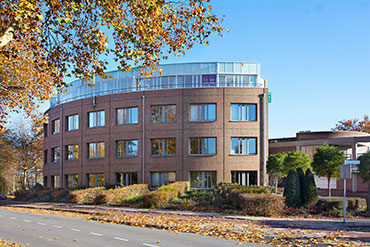To generate sustainable heat, there are various possibilities. Below we explain three of these.
Heat pumps
It is currently a common concept to wish to get rid of natural gas. In order to generate heat sustainably, heat pumps can be used, among other things. The hot water or steam boiler is replaced by a heat pump. This is already common practice for hot water. It is important though that there is residual heat at a sufficiently higher temperature, in order to keep the increase in temperature by the heat pump limited. As the temperature increase increases, the efficiency of the heat pump decreases. This is often indicated through the COP (Coefficient or Performance). The higher the COP is the lower the electricity consumption will be.
A big advantage of the installation is that it allows you to both heat and cool your interior, by reversing the principle in the summer. Especially when there is a cooling question, a heat pump system is actually always recommended. Often an existing cooling system can heat as well which means you already have a heat pump without being aware of it. Even better is to make use of the coldness of the soil when cooling. Which allows you to cool with minimal electricity consumption. CCS has designed several systems and is happy to assist you with the complex issue of optimizing your heat pump system. A particular point of attention for systems that use soil heat or cold is the adjustment. The system must extract as much heat as cold from the soil. CCS will also gladly advise you in this.
Biomass
Yet another form of sustainable heat generation is made possible through the use of biomass. There are a few possibilities here: fermentation, gasification, combustion and torrefaction.
- For example, biogas can be generated through fermentation, which can be used in your process boiler or CHP for the generation of heat. This biogas can be provided by a farmer, but also from a sewage treatment plant or landfill.
- Syngas can be produced through the gasification of biomass. This is useful, for example, when you produce a chemical from syngas.
- You can also burn wood to use heat in your production process. To determine whether this can be the solution you need in order to replace natural gas or oil, or simply to realize a saving, you can fill in the Wood Combustion Feasibility scan.
- Lastly there is torrefaction. This is the roasting of biomass. The main advantage of this method is that biomass streams that were initially less suitable for use in a process, now are suitable. For example, torrefied wood in a coal-fired power plant or torrefied straw in a wood boiler.
Sewage Heat
The traditional way to control the indoor climate of buildings is heating in the winter and applying air conditioning in the summer. However, there is an alternative way, namely energy from sewage. This could lead to considerable savings on fossil fuels. Sewage heat and cold is available almost everywhere. The most efficient application of this principle is when using low-temperature heating, such as underfloor heating. However, this principle is also applicable for conventional heating systems. The technique is applicable for buildings or -complexes with medium size such as:
- Appartement buildings
- Office buildings
- Schools
- Theaters
- Hospitals
- Industries
- Swimming pools
Application
The temperature of the sewage water varies during the year between about 10 ° C in winter and 20 ° C in summer. To extract heat from this or supply heat to it correctly, a heat exchanger in combination with a heat pump is needed. The sewage water flows over the heat exchanger, whereby heat is added or withdrawn from a closed water circuit. This water circuit is connected to a heat pump, which in turn is connected to the network of pipes leading to the building(s). This explaination shows that the sewage water and the heating circuit are separate systems.
Financial feasibility
Climate control based on sewage heat and cold requires investments in a heat exchanger, a heat pump and a network of pipes. The energy costs will however fall substantially. Generally, the investment is recouped within 5 to 10 years. CCS offers you the opportunity to perform a quick scan with which the general feasibility of such a system can be determined in a short period of time.
Independent advice
The technology to extract heat and cold from the sewers is on the rise. In Switzerland and Germany the principle has been successfully implemented several times, but in the Netherlands it is still a relatively new concept. CCS is involved as an independent consultant in one of the first sewage heat projects in the Netherlands. Based on our experience and independence, we offer our client support on both a technological level and in communication with suppliers.


